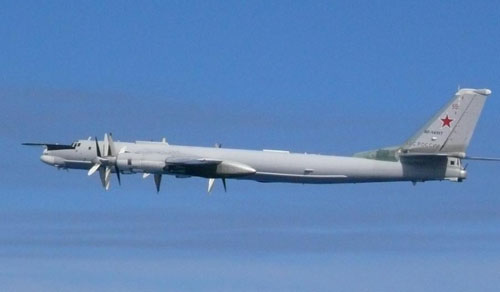by WorldTribune Staff, July 23, 2019
South Korea scrambled jets and reportedly fired hundreds of warning shots as a Russian A-50 aircraft, which was engaged in a joint air patrol with China on July 23, entered South Korean air space.
Just before the Russian aircraft entered South Korean airspace, two Russian Tu-95 bombers and two Chinese H-6 warplanes — both nuclear capable — had reportedly entered South Korea’s air defense identification zone (KADIZ).

“This is the first time I’m aware of that Chinese and Russian fighters have jointly flown through the air defense identification zone of a major U.S. ally — in this case two U.S. allies. Clearly it’s geopolitical signaling as well as intelligence collection,” said Michael Carpenter, a former Russia specialist with the U.S. Department of Defense.
Tara O, director at East Asia Research Center and a Lieutenant Colonel in the U.S. Air Force (ret.), tweeted: “1 Russian early warning & control aircraft entered ROK #airspace—1st time Russia violated ROK airspace since the Korean War. ROK Air Force responded w warning shots.”
The Russian violation of South Korean airspace was seen as a warning to the United States and Japan, said Hong Hyun-Ik, a senior researcher at the Sejong Institute, a private think tank in Seoul.
“This is a message to the U.S., Japan, and South Korea: ‘If you strengthen the U.S.-Japan military alliance, we have no choice but to react militarily as well,’ ” Hong said.
The incident was also aimed at testing South Korean defense systems, said Oh Yeon-Goon, a retired South Korean air force general.
The incident occurred near Dokdo, an island in the East Sea that is controlled by South Korea and claimed by both South Korea and Japan (which calls it Takeshima), according to the South Korean military.
The joint Russia-China mission, the first of its kind, received a strong protest from Japan, which said it also scrambled fighter jets in response.
“The reported incident occurred in a region where Russian, Chinese and U.S. interests converge around North Korea, and could exacerbate animosity between Washington and Moscow,” the Wall Street Journal reported. “The incident also comes after Seoul accused Chinese military planes of flyovers near South Korea at least six times last year.”
After the Russian A-50 aircraft flew reportedly flew into the airspace over Dokdo, South Korea scrambled 18 fighter jets that fired 360 machine gun rounds and released flares, Seoul’s Defense Ministry said. The Russian A-50 entered and exited South Korean airspace twice, the ministry said.
It was the first time that a Russian military aircraft violated South Korean airspace, a senior South Korean official said.
Russia’s Defense Ministry said it did not recognize South Korea’s KADIZ, while the Chinese Foreign Ministry said the area was not territorial airspace and that all countries enjoyed freedom of movement in it. Air defense zones, which aren’t part of a country’s sovereign territory, have been used by countries in the region to track each other’s movements.
Russia’s Defense Ministry also claimed that South Korean fighters did not fire any warning shots toward Russia’s two bombers and made no mention of any A-50 aircraft.
Moscow accused the two South Korean F-16 fighter planes of carrying out “unprofessional maneuvers,” of crossing the path of the Russian bombers, and of not communicating with them.
The former Soviet Union supported North Korea and provided the country with weapons during the Korean War, which killed millions.
In 1983, a Soviet air force fighter jet fired an air-to-air missile at a South Korean passenger plane, KAL Flight 007, that strayed into Soviet territory, killing all 269 people on board including U.S. Rep. Larry McDonald, a prominent conservative Republican from Georgia. Relations between Seoul and Moscow gradually improved, and they established diplomatic ties in 1990, a year before the breakup of the Soviet Union.
Japan lodged a complaint with both South Korea and Russia over the incident, Chief Cabinet Secretary Yoshihide Suga said.
Tokyo criticized South Korea for taking action against a Russian plane over what Japan says is its airspace.
“In light of Japan’s stance regarding sovereignty over Takeshima, the fact that the South Korean military aircraft carried out warning shots is totally unacceptable and extremely regrettable,” Suga told reporters.
The first printed reference of “Dokdo” was in a Japanese warship’s logbook. Both North and South Korea agree on the sovereignty of the resource-rich islets and reject Japan’s claim.
Intelligence Brief __________ Replace The Media
